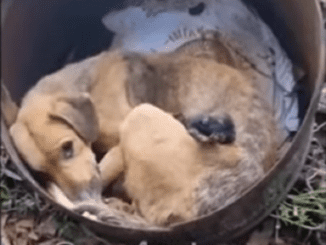4 Amazing Vermilion Flycatcher Facts
_(25352802099).jpg)
- It was observed that the male Vermilion Flycatcher lost its bright color if it was kept in captivity. Even though it is not the kind of bird seen interacting with humans, it would not be the best idea to keep them as a pet.
- People have a superstition about this bird where they regard it as the good luck bird.
- The males put up an engaging dance in the sky to impress females when it has to mate.
- Their species is a kind that leaves their young to be tended by others which is also called brood parasitism.
Where to Find Vermilion Flycatcher?
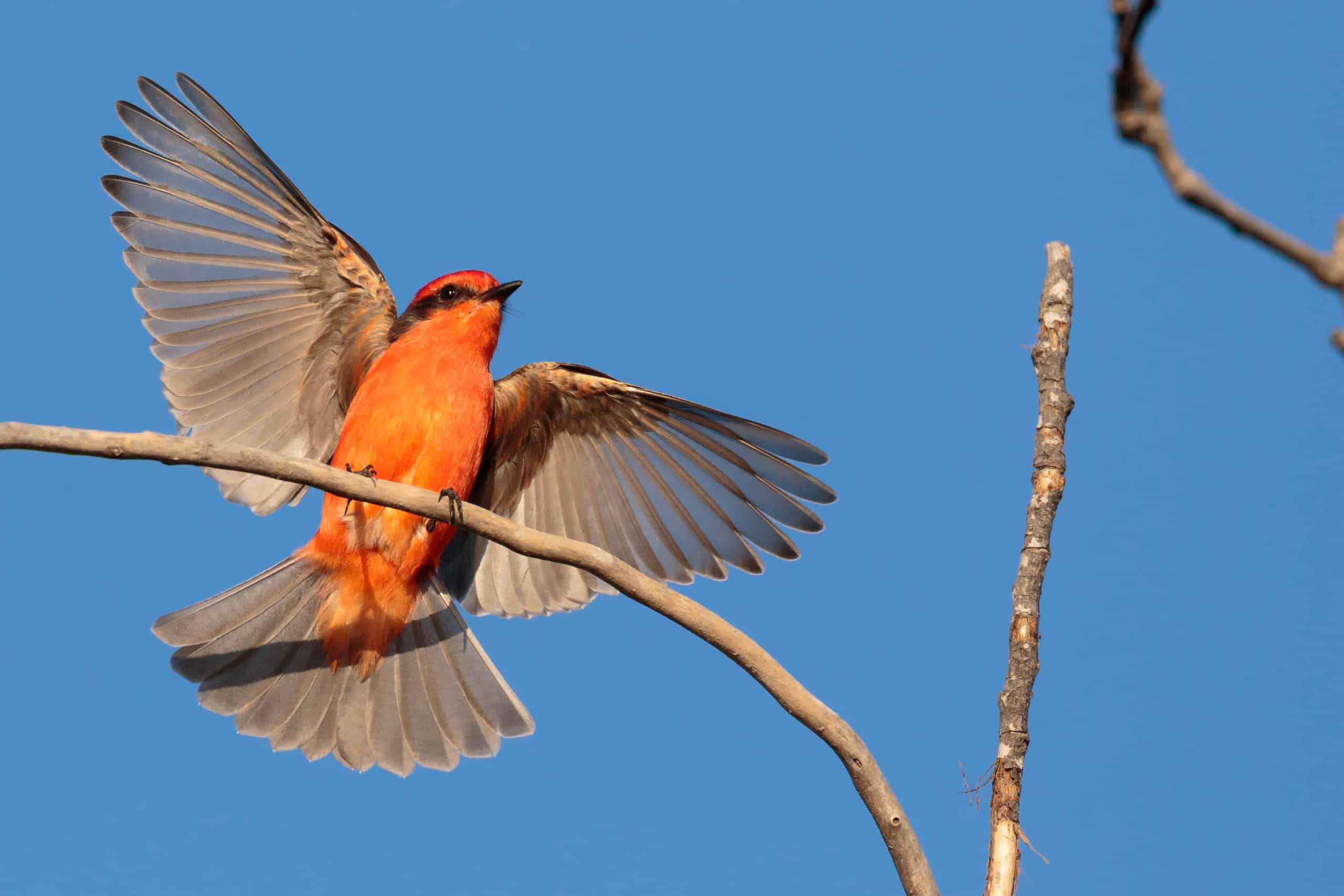
If you are on the watch for the Vermilion Flycatcher, you can look for them during any season. They are usually residing in woodland areas, scrublands, farmlands, deserts, parks, savannas, shrubby areas, and even near water. You can spot them in both Southern and Northern America and at elevations of 10,000 ft above sea level. But the best place to look for them is in insect-rich areas during the months of December to May. This is also their breeding season.
You will need to have a good eye because they will be perched on top of trees or near lakes, showcasing their majestic beauty. They are easily identifiable with their vibrant red and orange coloration while the females appear gray. Moreover, their sweet songs can be heard from far which you can follow to spot them with ease.
All in all, any open area is a good resting site for them, even if it is on street lights along the road. So, you won’t find much trouble spotting them. However, during the breeding season, they are found to prefer specific trees and plants. They include cottonwood, mesquite tree canopies, and Goodding’s willow. A suitable time to look for them is during the winters when they are found in flocks.
Vermilion Flycatcher Nests
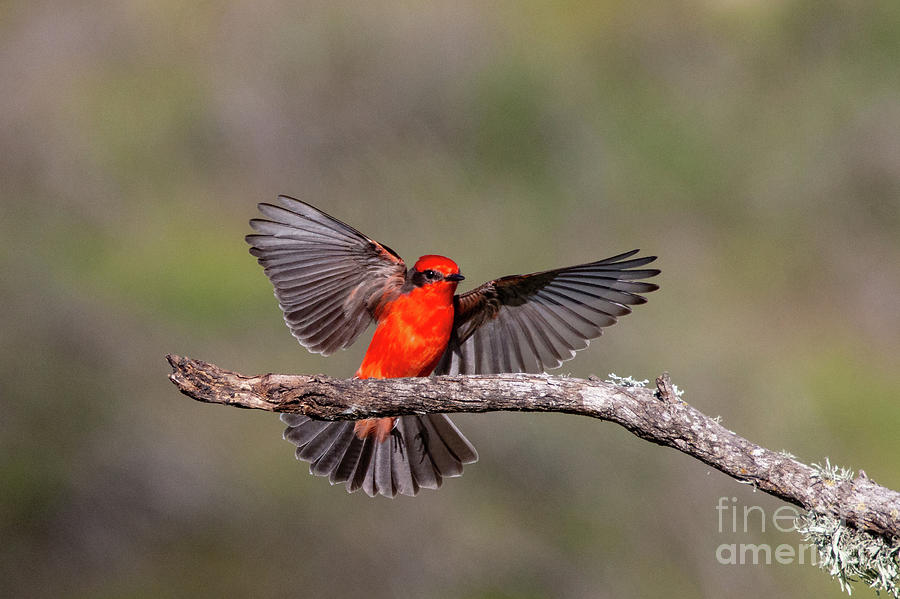
They have quite a unique structure for the nest. The cup is made up of twigs, grass, empty cocoons, and a spider web to wrap it up as a whole. In addition, you will find it hidden under lichen as a way to camouflage it from predators. It is also lined up with feathers, hair, and other plant components.
The nest of a Vermilion Flycatcher is usually perched up on the trees, around 20 inches up. Rarely, you can find a Vermilion Flycatcher’s nest that is perched higher than 50 inches from the ground but it has happened. There may be 2-4 eggs and they are white in color with a few brown/olive/lavender spots.
Vermilion Flycatcher Scientific name
The Vermilion Flycatcher was first called the Pyrocephalus obscurus in 1839 and then in 1840, it was also identified as Pyrocephalus rubinus. Today, both names which are Greek in origin, are considered for their description although, Pyrocephalus rubinus is used for another bird known as Scarlet Flycatcher. The Vermilion Flycatcher belongs to the Class Aves and the Tyrannidae family.
Up till 2013, people thought that it had nearly 13 species but this claim was disregarded by a 2016 study. It further claimed that the Vermilion Flycatcher only has nine subspecies, which are as follows;
- P. o. obscurus
- P. o. mexicanus
- P. o. saturatus
- P. o. blatteus
- P. o. flammeus
- P. o. ardens
- P. o. cocachacrae
- P. o. piurae
- P. o. pinicola
Vermilion Flycatcher Size, Appearance, & Behavior
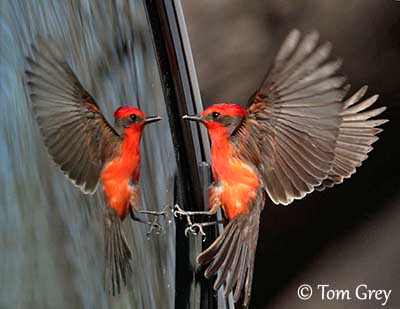
The Vermilion Flycatcher is a small and round bird with a straight bill. It has a short head but a barrel-chested and stout body. Its tail, however, is long and slender. It measures up to 5.1 to 5.5 inches in length and 3.1 inches in height. Their weight is around 0.39 to 0.49 ounces while their wingspan spreads to a brilliant 9.4 to 9.8 inches.
Both the genders are distinctly different in colors. Males have very vibrant reddish orange undertones below a brown mask of feathers covering the body. As for the females, they are grey in color with white undertones and an astounding brush of amber shades running below. Males are distinguishedly different but the females are often confused with the Say’s phoebe.
Vermilion Flycatcher Migration Pattern and Timing
Migration is vital for the Vermilion Flycatcher as it has helped in expanding their population. However, there is one interesting fact about their migration pattern based on geography. The Southern birds are the ones that migrate to the North while the Northern birds are quite reluctant about migrating making them non-migratory for good. The migration season starts in early March and helps them move to the warmer regions.
The Vermilion Flycatcher is usually found in solitude. During the winter season, however, some are gathered around in flocks but not more than five altogether.
Vermilion Flycatcher Diet
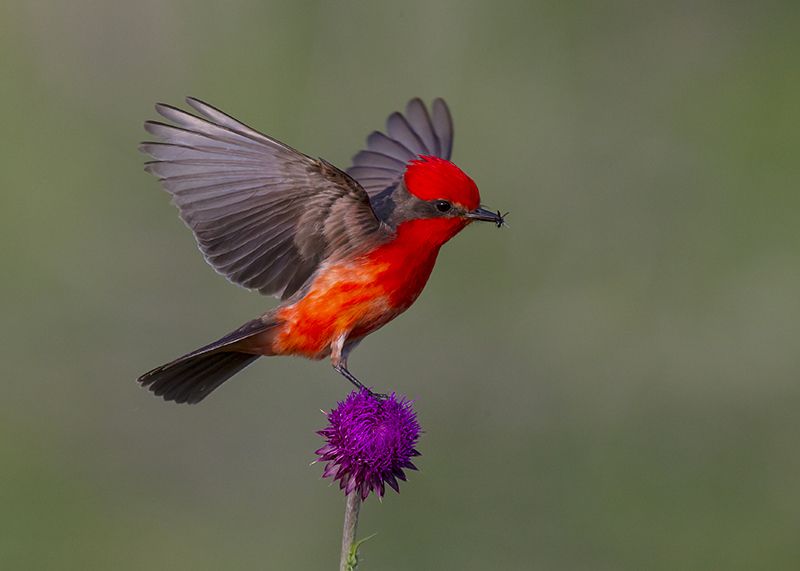
Their diet usually includes insects. Some of them are honeybees, butterflies, grasshoppers, beetles, and crickets. They are strictly insectivores in nature.
What does Vermilion Flycatcher Eat?
They eat a variety of insects, ranging from the big ones like butterflies and grasshoppers to the small ones like crickets and beetles. The indigestible parts of their diet come out of their mouths in the form of pellets.
What is the Vermilion Flycatcher’s Feeding Nature?
They are perched in high places to get a better bird’s eye view of their surroundings. Once they spot an insect, they swoop in and bring the insect back to their perching site. They might even come down to the ground if there is sweet prey lurking around them. After bringing back their prey, they kill them before they eat them up.
Vermilion Flycatcher Predators, Threats, and Conservation Status
The Vermilion Flycatcher does not face any current threats to its population size. It belongs to the Least Concern category in its conservation status. Its population is currently increasing and is because of its migration pattern.
What eats Vermilion Flycatcher?
The most common predator, especially in Galapagos, are rats. They do not just eat their eggs but also their young.
What Is a Big Threat to the Vermilion Flycatcher?
Urbanization is a big threat to the population of the Vermilion Flycatcher. Because of deforestation, they do not have many homes where they can reside. Similarly, the overuse of pesticides has caused the insects to die which opens up a survival case for the Vermilion Flycatcher.
Reproduction, Young, and Molting of Vermilion Flycatcher
The mating is due to a little performance by the male. They go up high in the sky to flash their dance “routines” along with a little singing that eventually enables mating. The males form a puffy chest and engage in a fluttery fight.
The Vermilion Flycatcher does not stay with one partner in their lives. The males engage with other females through their mating rituals while the females fly away and lay eggs in other Vermilion Flycatchers’ nests. But this is true for only a small amount of the total population since there is only 11% of the babies have come out this way.
The female begins building the nest and keeps on tweaking it to her liking. She lays 2 to 4 eggs which are white in color with dark spots on them. After an incubation period of 2 weeks, the hatchlings emerge known as chicks. They are underdeveloped babies which are fed by both parents. But because of brood parasitism, the young are often left to be tended with care by other birds. After 15 days, the chicks are ready to leave the nest and after two years, they can mate.
As for the molting, it begins after migration season, in July, and may last up to September. The broken feathers are replaced by this process which may take up to 79 days. But many birds complete it within 62 days as well. The reason for slow molting is that the quick process may create underdeveloped feathers, causing trouble during flight.
Population
The population size of the Vermilion Flycatcher is around 5,000,000 to 50,000,000 individuals. They are also considered in the Least Concern category of Endangered Species. This high number is mainly because they migrate quite often.
In addition, their population size is increasing even though there is a danger to their survival if urbanization and overuse of pesticides keep increasing every day.
